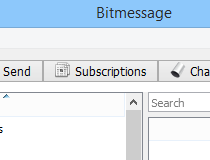

The email address that correspond to each Bitmessage address in the "addresses" section of the gateway configuration file in the form = BM-xxxxxxx.

Incoming Bitmessage messages are now sent to a local email address, actually any email address would do, but if it's not local, then the security of using Bitmessage would be compromised. I've made a couple of Python scripts, bm-gateway/in.py and bm-gateway/out.py which utilise the functionality of bmwrapper on hosts that already have a running mail server and acts as a gateway between the local Bitmessage instance and the mail server without starting up an additional SMTP and POP server. This is quite secure because both sending and receiving is done over encrypted channel to our own server. So I've decided to run it on the server as a daemon (using these settings to start it automatically as a service), and then integrate it with Exim so that I can receive the messages in my usual inbox. When I do run it I have to wait a long time before messages will arrive. I've been finding Bitmessage difficult to run especially as our net connection can be very low bandwidth, so often I won't run it for days at a time and then miss out on messages. See more on the Open Transactions article. Tcp 0 0 0.0.0.0:8444 0.0.0.0:* LISTEN 3577/python2.7 Bitmessage + Open TransactionsĪ very interesting thread started in BitcoinTalk here about joining Bitmessage with Open Transactions to produce a completely p2p anonymous transaction system far superior to Bitcoin or Ripple in terms of security, anonymity and the power of financial instruments it provides. You can check if they're running with netstat -nlp and check you have apps listening on 8442, 1235, e.g.This complicated procedure is required because each one is a daemon that doesn't return and won't run in the background using the ampersand.

Ensure all the launchers have executable permission.Python2.7 ~/PyBitmessage/src/bitmessagemain.py Create each of the three launchers one to run each of the scripts with python2.7, for example the first of mine is:.Create your launcher script that runs another separate launch script for each of the three e.g.desktop file that runs a launcher shell script Set up an account on your mail client to localhost, POP3 on 12344 and SMTP on 12345 as shown here.
#Bitmessage protocol install#
Install the bmwrapper into your home (I used git clone again).Install the PyBitmessage-Daemon script into your home folder (I used git clone for easy update) and run it with python daemon.py.First enable the Bitmessage API in your local keys.dat configuration file.This means the messages can be organised in a local folder structure or easily coped to your IMAP structure. Use your mail client as the UI with bmwrapperīrilliant little script that sets up a basic POP3 and SMTP server on localhost to give Bitmessage an email interface for example that Thunderbird can connect to. You can then type the command apiTest to see if the connection to the local Bitmessage is working properly, and if so, do help to see a list of available commands you can issue. Sudo -u bmuser python2.7 /home/bmuser/PyBitmessage-Daemon/daemon.py For example if we're running as the unprivileged user bmuser we would run it as follows: Also for some reason they've used "python-2.7.x" in the shebang statement at the start of the script so you can't run the script directly, you need to call it via python2.7. config/PyBitmessage location so if you run Bitmessage under an unprivileged user you'll need to use the sudo command to run the script first. Note that the key file is found by checking the home directory's.
#Bitmessage protocol password#
When the PyBitmessage-Daemon/daemon.py script is run it will connect to the local Bitmessage service using the API use and password found in the key.dat file of the Bitmessage's configuration. And create a desktop launcher for it as shown in our GNOME article.įor use on servers or for testing local applications that use the Bitmessage via its API you can install the PyBitmessage-Daemon which can just be unpacked into the same location as PyBitmessage. You may need to install python-qt4 first, then simply git clone it as shown here. Installation is very simple on modern GNU/Linux based operating systems.


 0 kommentar(er)
0 kommentar(er)
